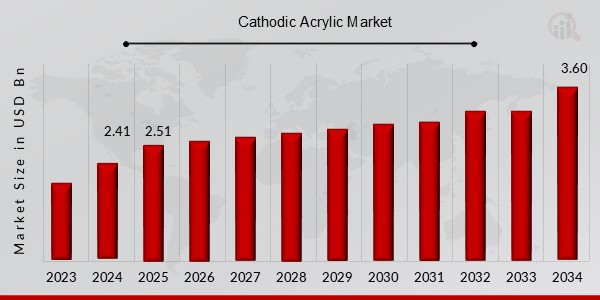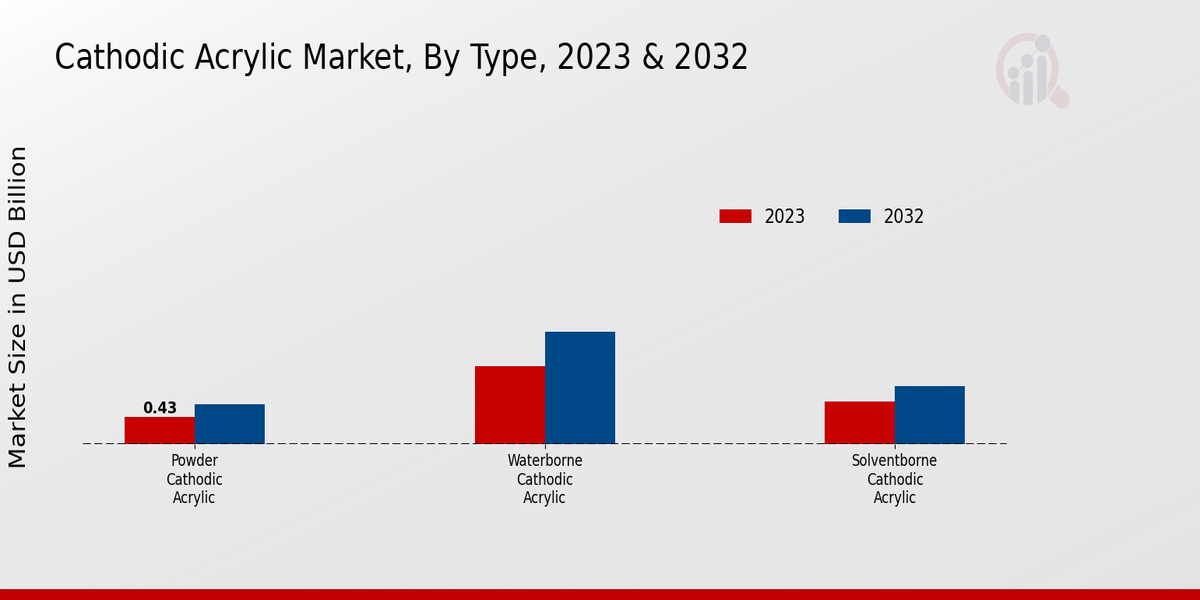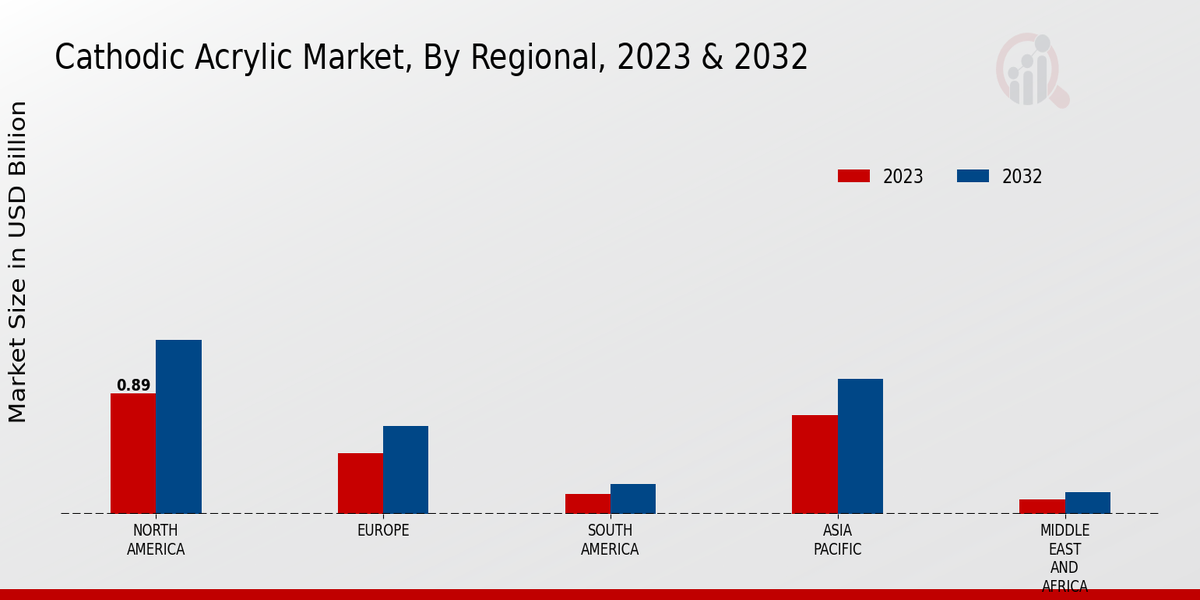Global Cathodic Acrylic Market Overview
The Cathodic Acrylic Market Size was estimated at 2.41 (USD Billion) in 2024. The Cathodic Acrylic Industry is expected to grow from 2.51 (USD Billion) in 2025 to 3.60 (USD Billion) by 2034. The Cathodic Acrylic Market CAGR (growth rate) is expected to be around 4.1% during the forecast period (2025 - 2034).
Key Cathodic Acrylic Market Trends Highlighted
The cathodic acrylic market is influenced by several crucial trends. One prominent trend is the growing emphasis on corrosion protection in various industries, including automotive, construction, and marine. The increasing demand for lightweight and durable materials is driving the adoption of cathodic acrylic coatings, which provide excellent corrosion resistance and adhesion properties. Additionally, the rising awareness of environmental regulations is encouraging the use of eco-friendly coatings, further propelling the demand for cathodic acrylics.Emerging opportunities in the cathodic acrylic market lie in the development of innovative coating technologies. The integration of nanotechnology and advanced resins is enhancing the performance of these coatings, offering improved barrier properties, scratch resistance, and chemical resistance. The increasing adoption of cathodic acrylic coatings in the renewable energy sector, particularly in offshore wind turbines and solar panel installations, presents significant growth potential for the market.Recent industry trends indicate a shift towards waterborne cathodic acrylic coatings. These coatings offer environmental advantages, such as lower VOC emissions and reduced hazardous waste generation, making them a preferred choice for sustainable construction and manufacturing processes. The demand for high-performance cathodic acrylic coatings is also growing, driven by the need for enhanced protection against harsh environmental conditions in industries such as mining, oil and gas, and chemical processing.

Source: Primary Research, Secondary Research, MRFR Database and Analyst Review
Cathodic Acrylic Market Drivers
Rising Demand for Corrosion Protection in Infrastructure
The increasing need to protect critical infrastructure from corrosion is a major driver of growth for the cathodic acrylic market. Infrastructure assets such as bridges, pipelines, and storage tanks are exposed to harsh environmental conditions that can lead to corrosion, which can compromise their integrity and safety. Cathodic acrylic coatings provide a cost-effective and long-lasting solution for protecting these assets from corrosion, extending their lifespan and reducing maintenance costs.The growing awareness of the benefits of cathodic acrylic coatings is expected to continue to drive demand for these coatings in the infrastructure sector.
Advancements in Cathodic Acrylic Technology
Ongoing advancements in cathodic acrylic technology are also contributing to the growth of the Cathodic Acrylic Market Industry. These advancements include the development of new coating formulations that offer improved performance, durability, and application properties. For instance, self-healing cathodic acrylic coatings are gaining traction due to their ability to repair themselves when damaged, providing extended protection to the underlying substrate.Additionally, the development of waterborne cathodic acrylic coatings is reducing the environmental impact of these coatings, making them more sustainable.
Increasing Adoption in Marine Applications
The marine industry is witnessing a growing adoption of cathodic acrylic coatings for protecting ships, boats, and offshore structures from corrosion. The harsh marine environment, characterized by saltwater and high humidity, can cause severe corrosion to metal surfaces. Cathodic acrylic coatings offer excellent resistance to these corrosive conditions, preventing damage and prolonging the lifespan of marine assets. The rising demand for marine transportation and the expansion of offshore activities are expected to drive the adoption of cathodic acrylic coatings in the marine industry.
Cathodic Acrylic Market Segment Insights
Cathodic Acrylic Market Type Insights
The Cathodic Acrylic Market is segmented by Type into Waterborne Cathodic Acrylic, Cathodic Acrylic, and Powder Cathodic Acrylic. Among these, the Waterborne Cathodic Acrylic segment accounted for the largest market share in 2023 and is expected to continue its dominance during the forecast period. The growth of this segment can be attributed to the increasing demand for eco-friendly and sustainable coatings, as waterborne cathodic acrylics contain low levels of volatile organic compounds (VOCs). Additionally, waterborne cathodic acrylics offer excellent corrosion protection and adhesion properties, making them suitable for a wide range of applications.The Solvent borne Cathodic Acrylic segment is expected to witness steady growth during the forecast period. Solvent borne cathodic acrylics are known for their high performance and durability, which makes them ideal for use in harsh environments. However, the stringent regulations on the use of solvents are expected to restrain the growth of this segment to some extent. The Powder Cathodic Acrylic segment is anticipated to grow at a significant rate during the forecast period. Powder cathodic acrylics are gaining popularity due to their ease of application, low VOC emissions, and excellent corrosion resistance.They are widely used in the automotive, marine, and construction industries. Overall, the Cathodic Acrylic Market is expected to exhibit a steady growth rate during the forecast period, driven by the increasing demand for corrosion-resistant coatings in various industries. The growing awareness about the environmental impact of solvent-based coatings is expected to further boost the demand for waterborne and powder cathodic acrylics.

Source: Primary Research, Secondary Research, MRFR Database and Analyst Review
Cathodic Acrylic Market Application Insights
The Cathodic Acrylic Market is segmented based on application into Automotive Transportation, Industrial Protective Coatings, Marine Protective Coatings and Architectural Coatings. The Automotive Transportation segment is projected to account for the largest revenue share in the Cathodic Acrylic Market by 2023, owing to the increasing demand for lightweight and durable materials in the automotive industry. The Industrial Protective Coatings segment is also expected to witness significant growth, driven by the rising demand for corrosion protection in various industrial applications.The Marine Protective Coatings segment is anticipated to grow at a steady pace, supported by the increasing demand for protective coatings in marine environments. The Architectural Coatings segment is projected to experience moderate growth, driven by the growing demand for architectural coatings in the construction industry.
Cathodic Acrylic Market End-Use Industry Insights
The Cathodic Acrylic Market is segmented into various end-use industries, including Automotive OEM, Automotive Aftermarket, Construction, Industrial Manufacturing, and Aerospace Defense. Automotive OEM is the largest segment, accounting for over 30% of the Cathodic Acrylic Market revenue in 2023. The growth of this segment is attributed to the increasing demand for lightweight and durable materials in the automotive industry. The Automotive Aftermarket segment is expected to grow at a CAGR of 4.5% during the forecast period, driven by the rising demand for vehicle maintenance and repair services.The Construction segment is another major end-use industry for Cathodic Acrylic, with a market share of around 25% in 2023. The growing construction activities, particularly in emerging economies, are expected to drive the demand for Cathodic Acrylic in this segment. Industrial Manufacturing is another significant end-use industry for Cathodic Acrylic, with a market share of approximately 20% in 2023. The increasing demand for Cathodic Acrylic in various industrial applications, such as machinery, equipment, and appliances, is expected to drive the growth of this segment.The Aerospace Defense segment is expected to witness steady growth during the forecast period, driven by the rising demand for lightweight and corrosion-resistant materials in the aerospace and defense industries.
Cathodic Acrylic Market Technology Insights
The technology segment is a key aspect of the Cathodic Acrylic Market, encompassing different techniques used to produce cathodic acrylic resins. These techniques include Emulsion Polymerization, Solution Polymerization, and Suspension Polymerization. Emulsion Polymerization, which accounted for the largest share of the Cathodic Acrylic Market revenue in 2023, involves the formation of polymer particles in an aqueous medium. This technique offers advantages such as high solids content, low viscosity, and good film-forming properties, making it suitable for various applications.Solution Polymerization, on the other hand, utilizes organic solvents as the reaction medium. It provides better control over molecular weight and composition, resulting in polymers with specific properties tailored to specific end-use applications. Suspension Polymerization involves the formation of polymer beads in a liquid suspension. This technique offers high conversion rates and produces polymers with uniform particle size and narrow molecular weight distribution. The choice of technology depends on factors such as desired polymer properties, production scale and cost-effectiveness.As the Cathodic Acrylic Market continues to grow, advancements in technology are expected to drive innovation and expand the scope of applications for cathodic acrylic resins.
Cathodic Acrylic Market Regional Insights
The regional segmentation of the Cathodic Acrylic Market offers insights into the market's geographic distribution and growth patterns. North America holds a significant share of the market, driven by the presence of major manufacturers and high demand from industries such as automotive, construction, and electronics. Europe is another key region, with a strong presence of automotive and chemical industries contributing to market growth. The Asia-Pacific region is projected to witness the highest growth rate during the forecast period, owing to rapid industrialization and urbanization in countries like China and India.South America and the Middle East Africa regions are expected to contribute a smaller share to the overall market but are expected to grow steadily due to increasing infrastructure and construction activities. Key factors driving the regional growth of the Cathodic Acrylic Market include government regulations, technological advancements, and rising demand from end-use industries. Understanding the regional dynamics of the market is crucial for businesses to tailor their strategies and capitalize on growth opportunities.

Source: Primary Research, Secondary Research, MRFR Database and Analyst Review
Cathodic Acrylic Market Key Players And Competitive Insights
Major players in Cathodic Acrylic Market are constantly striving to gain a competitive edge by investing in research and development to enhance their product offerings and cater to the evolving needs of their customers. The Cathodic Acrylic Market industry is characterized by a high level of competition, with leading Cathodic Acrylic Market players employing various strategies to differentiate their products and services. These strategies include product innovation, strategic partnerships, and acquisitions to expand their market reach and strengthen their position in the industry.A leading player in the Cathodic Acrylic Market is Arkema, a specialty chemicals company. Arkema's Cathodic Acrylic Market division focuses on providing a range of high-performance acrylic resins for various applications, including protective coatings, adhesives, and sealants. The company has a strong presence with manufacturing facilities in Europe, North America, and Asia, enabling it to cater to the needs of customers worldwide. Arkema's commitment to innovation has resulted in the development of advanced Cathodic Acrylic Market products that meet the specific requirements of various industries.A notable competitor in the Cathodic Acrylic Market is BASF, a leading chemical company headquartered in Germany. BASF's Cathodic Acrylic Market division offers a comprehensive portfolio of acrylic resins and solutions for a wide range of applications. The company has a network of production sites and technical centers, allowing it to serve customers in different regions effectively. BASF emphasizes sustainability in its operations and has implemented various initiatives to reduce its environmental footprint, which aligns with the growing demand for eco-friendly products in the Cathodic Acrylic Market industry.
Key Companies in the Cathodic Acrylic Market Include
- Sanyo Chemical Industries, Ltd.
- Arkema
- Nippon Shokubai Co., Ltd.
- Air Products and Chemicals, Inc.
- Linde AG
- Dow
- Kaneka Corporation
- Taiyo Nippon Sanso Corporation
- Evonik
- Praxair, Inc.
- Mitsubishi Chemical Corporation
- Sumitomo Chemical Co., Ltd.
- BASF
- DIC Corporation
Cathodic Acrylic Market Industry Developments
The market growth is attributed to the increasing demand for cathodic acrylic coatings in various industries, including automotive, marine, and construction. Cathodic acrylic coatings provide excellent corrosion protection, chemical resistance, and durability, making them suitable for a wide range of applications.Recent developments in the market include the introduction of new products with enhanced properties, such as improved adhesion, flexibility, and weather resistance. Major players in the market are focusing on research and development to develop innovative solutions that meet the evolving needs of customers. Strategic partnerships and acquisitions are also being pursued to expand market presence and gain access to new technologies.
Cathodic Acrylic Market Segmentation Insights
Cathodic Acrylic Market Type Outlook
- Waterborne Cathodic Acrylic
- Solventborne Cathodic Acrylic
- Powder Cathodic Acrylic
Cathodic Acrylic Market Application Outlook
- Automotive Transportation
- Industrial Protective Coatings
- Marine Protective Coatings
- Architectural Coatings
Cathodic Acrylic Market End-Use Industry Outlook
- Automotive OEM
- Automotive Aftermarket
- Construction
- Industrial Manufacturing
- Aerospace Defense
Cathodic Acrylic Market Technology Outlook
- Emulsion Polymerization
- Solution Polymerization
- Suspension Polymerization
Cathodic Acrylic Market Regional Outlook
- North America
- Europe
- South America
- Asia Pacific
- Middle East and Africa
| Report Attribute/Metric |
Details |
| Market Size 2024 |
2.41 (USD Billion) |
| Market Size 2025 |
2.51 (USD Billion) |
| Market Size 2034 |
3.60 (USD Billion) |
| Compound Annual Growth Rate (CAGR) |
4.1% (2025 - 2034) |
| Report Coverage |
Revenue Forecast, Competitive Landscape, Growth Factors, and Trends |
| Base Year |
2024 |
| Market Forecast Period |
2025 - 2034 |
| Historical Data |
2020 - 2024 |
| Market Forecast Units |
USD Billion |
| Key Companies Profiled |
Sanyo Chemical Industries, Ltd., Arkema, Nippon Shokubai Co., Ltd., Air Products and Chemicals, Inc., Linde AG, Dow, Kaneka Corporation, Taiyo Nippon Sanso Corporation, Evonik, Praxair, Inc., Mitsubishi Chemical Corporation, Sumitomo Chemical Co., Ltd., BASF, DIC Corporation |
| Segments Covered |
Type, Application, End-Use Industry, Technology, Regional |
| Key Market Opportunities |
1. Expanding construction 2. industry demand for protective coatings 3. growth in the automotive sector 4. rising environmental concerns and 5. increasing demand for electronics |
| Key Market Dynamics |
1. Rising construction activities 2. Growing demand for protective coatings 3. Advancements in technology 4. Increasing environmental regulations 5. Expanding automotive industry |
| Countries Covered |
North America, Europe, APAC, South America, MEA |
Frequently Asked Questions (FAQ) :
The Cathodic Acrylic Market was estimated to be valued at USD 2.41 billion in 2024.
The Cathodic Acrylic Market is projected to exhibit a CAGR of 4.1% from 2025 to 2034.
Rising demand for cathodic protection in various industries, increasing infrastructure development, and growing awareness of corrosion control are driving the growth of the Cathodic Acrylic Market.
Asia Pacific is expected to dominate the Cathodic Acrylic Market throughout the forecast period due to rapid industrialization and infrastructure development in the region.
Major applications of Cathodic Acrylic include pipelines, storage tanks, bridges, marine structures, and offshore platforms.
Key competitors in the Cathodic Acrylic Market include AkzoNobel, BASF, Jotun, PPG, and Sherwin-Williams.
The Cathodic Acrylic Market is projected to reach USD 3.60 billion by 2034.
Government regulations related to corrosion control and environmental protection positively impact the growth of the Cathodic Acrylic Market.
Technological advancements, such as the development of new coating materials and application techniques, are driving innovation and improving the performance of cathodic acrylic coatings.
Challenges include fluctuating raw material prices, stringent environmental regulations, and competition from alternative corrosion protection methods.
















